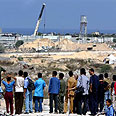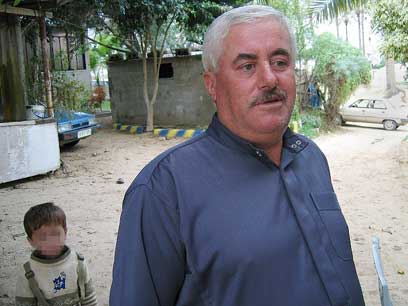
Gaza: Still no hope after disengagement
Follow up on disengagement shows no progress in development, infrastructure. Land owner describes difficulties in rebuilding, cultivating, urges changes, ‘I'm asking governments on both sides to allow simple people from both nations to live’
“We had 70 dunams of land. On the day that Neve Dekalim was built, bulldozers came and took about half of the land, more than 30 dunam. They bared the soil and built a fence along the length of the western part of the settlement.“
“But my land is not just in the western part, it extends to the eastern part as well. They stripped that part too and we watched them use its sands to build. They took our land, they built on it, and even used its sands for the construction of the settlement and we had no power.“

Hashem al-Ara (Abu Muhammad) (Photo: Ali Waked)
“You stand for 20 years, looking at the land you had slowly disappearing while things are built upon it, but not for us. It’s a sight I don’t wish on anybody. So I understand that it is painful for the settlers that they are forced to leave. Particularly those that were born here. Not their parents who came and stole our land. But thanks to Allah, land always returns to its owners.”
Over a year later, Ynet checked in on Abu Muhammed. He was still there, with his family, in the Muasi neighborhood in Gaza, and he remembers clearly the moments when he watched the tearing down of the settlements on his land.
“I sat on the top floor balcony and saw the bulldozers roll over Neve Dkalim. I was very happy. We hoped that our dreams were coming true,” he said. The Abu Muhammed of late 2006 is disheartened and disappointed. Although he can now walk on his land again, his rosy colored dreams are no more.
Huts remain empty alongside ruins
Even the ruins of Neve Dkalim, of which most have not been removed, don’t take away from the amazing view of the area. The splendid shores of the Strip can be seen through beautiful orchards.Muasi farmers were busy this week with the olive harvest. Beach huts remained orphaned. At the end of the disengagement, residents enviously watched the hut owners, thinking whoever had a hut was holding a gold mine.
But the huts remained empty. Other than a preliminary structure for a branch of the Gazan al-Aqsa University, no development could be seen in the Neve Dkalim area. There hasn’t been any real change since the day the bulldozers finished their work.
The lands may have returned, but what of the changes you hoped for? What of the big plans, the factories, the civil infrastructure you dreamt of?
“The land is back, and that’s something,” he said, “but to be honest, nothing has changed. On the contrary, then we were united, and now we are divided. The occupation isn’t over, but if last year it was a direct, suffocating, and cruel occupation, today it’s a little further. We’re still trapped in a cage, the cage is just a little bigger.”
Why haven’t you cultivated the land until now? Where are the crops you spoke of? The only thing left from Neve Dkalim is basically ruins.
“We have the desire to cultivate and move forward, but I’m afraid if I invest in cultivating the land, I won’t break even. The Israel’s won’t allow us to export and market our products because of the closure and siege.”
“That doesn’t only hurt my ability to export, but also to market within the Strip. If at one time tens of thousands of workers worked in Israel and brought a lot of money into the strip, today no one leaves and there is no money. That’s why every step I take could be financially devastating.”
In the meantime, Abu Muhammed has planted 10 duman of guava. According to him, as if the closure and siege aren’t enough of a problem, a new insect had entered the area and was making things difficult for the farmers.
The Palestinian Authority has not been able to deal with the situation. “The political situation, and the bugs - there is no reason to be optimistic,” he said.
Many Israelis would ask how it is that you are unable to recreate the financial and agricultural prosperity of the settlers that used to live here.
"I happen to know that the evacuees' situation is not that good too, not all of them succeeded in rebuilding their lives, and a large majority live on the streets or in camps and can only dream of what they had here. So, in this respect, us and the settlers are tied."
"On the issue of success, while the governments of Israel supported the settlers financially, supported them throughout the entire production, marketing and exporting process, we don't get any assistance, not in the level of planning what to sow or how to draft a business plan – not even on the level of compensation for damages, nothing."
But it's not only the agriculture, Abu Muhammad is troubled by the fact that the structures in the evacuated settlements that were used as colleges, kindergartens and schools and were left in a reasonable condition, stand empty.
"We thought we'd at least be able to use them, and we're not even doing that. In the meantime, nothing is happening with them," he said.
Abu Muhammad is convinced that the solution for the situation is in Israel's hands.
"If Israel decides to allow us to live, build, plant, market, export and run a normal life – we can succeed. If it decides not to let this happen, then nothing will change. I'm asking the governments on both sides to allow the simple people from both nations to live. If that happens, we'll have prosperity. In the meantime, it (the situation) looks grim," he concluded.










